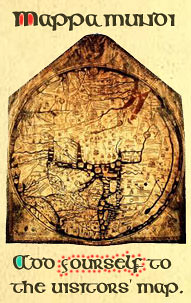Emperor Frederick Barbarossa
The orb topped with a cross in his hand symbolizes the world (spherical) ruled by the cross.

Of all the erroneous ideas in modern popular history, perhaps none annoys me more than the notion that mediaeval man thought that the world was flat. This persistent falsehood is almost always perpetuated in one of two ways: in reference to Christopher Columbus’ voyage to the New World or to the ignorance of the ‘Dark Ages’, particularly in allusion to mediaeval Christians.
New York Times columnist Thomas Friedman writes that “Columbus reported to his king and queen that the world was round, and he went down in history as the man who first made this discovery”. I hope Pythagoras and Aristotle weren’t reading MSNBC’s website that day. And then there is poor Eratosthenes. He knew that the sun was directly overhead at noon on the summer solstice at Syene, in Egypt. Assuming that the sun was so far away that its rays could be considered to be parallel, he used geometry and trigonometry to calculate the circumference of the earth based on a stick placed in the ground at Alexandria in c. 240 BC. He was within 2% and 20% of the actual measurement. Although a few isolated pagan philosophers and early Christians still doubted the round earth theory, the evidence points to the predominate belief in Western Civilization in a round earth since Classical Greece. It’s hard to argue with Bede, Thomas Aquinas, and Dante on the mediaeval weltanschauung. The myth may make the Columbus story more exciting – the adventurer and explorer convinces the crown that he can do the impossible, despite fears that he would sail off the end of the earth – but does it really make sense? This would be like the United States and Russia competing to go to a Moon that most people didn’t believe existed. Would NASA really have gotten the funding?
A mediaeval world map
So when was this falsehood born? Jeffrey Burton Russell at UCSB has tracked the invention to two individuals in 1830s France: the French anti-religious scholar Antoine-Jean Letronne and the American writer Washington Irving. My guess would be on the Frenchie, as he studied both geography and patristics, promoting the medieval flat earth view in On the Cosmographical Ideas of the Church Fathers. Depicting the mediaeval view as such would well fit his secular polemic. Irving popularized the idea that Columbus faced a hostile crowd of inquisitors and sinister theologians who ridiculed his plans to reach the east by sailing westward. Columbus was opposed not by silly, superstitious clerics who thought the world flat, but by wise men who knew the earth was rather larger than he estimated it to be. That he stumbled upon a unknown continent and did not perish crossing both the Atlantic and the Pacific is pure Serendipity.
The distortion probably survived in the case of Columbus because it made the story so much better to tell to schoolchildren. In a way, we rather like the idea of falling off the end of the earth. On a hike following High School, my friend Alex and I concluded that the world was none other than a giant pyramid standing on its tip and rotating like a top. Not that we believed this, mind you, but it does offer a more entertaining cosmology than a bunch of spheres. (The solar system is rather like a slow game of billiards…perhaps the Creator is off playing hungry hippos in another section of the universe?)
There is, however, another reason the myth survives. It was a useful attack on religious faith in the conflict between science and religion (when are we going to get an exit strategy on that war?), particularly in the debate over Darwinism. It became the standard attack by proponents of ‘science’ on proponents of ‘religion’: ‘these are the same ignorant fools who thought that the earth was flat’. Of course the ultimate irony of such attacks is that they display the ignorance of the attacker, not of the intended victim. And so should they. As Edward Grant observed, “If revolutionary rational thoughts were expressed in the Age of Reason, they were only made possible because of the long medieval tradition that established the use of reason as one of the most important of human activities”. I suppose the only solution is a more well-rounded history education.
Labels: 2005, History






0 Comments:
Post a Comment
<< Home